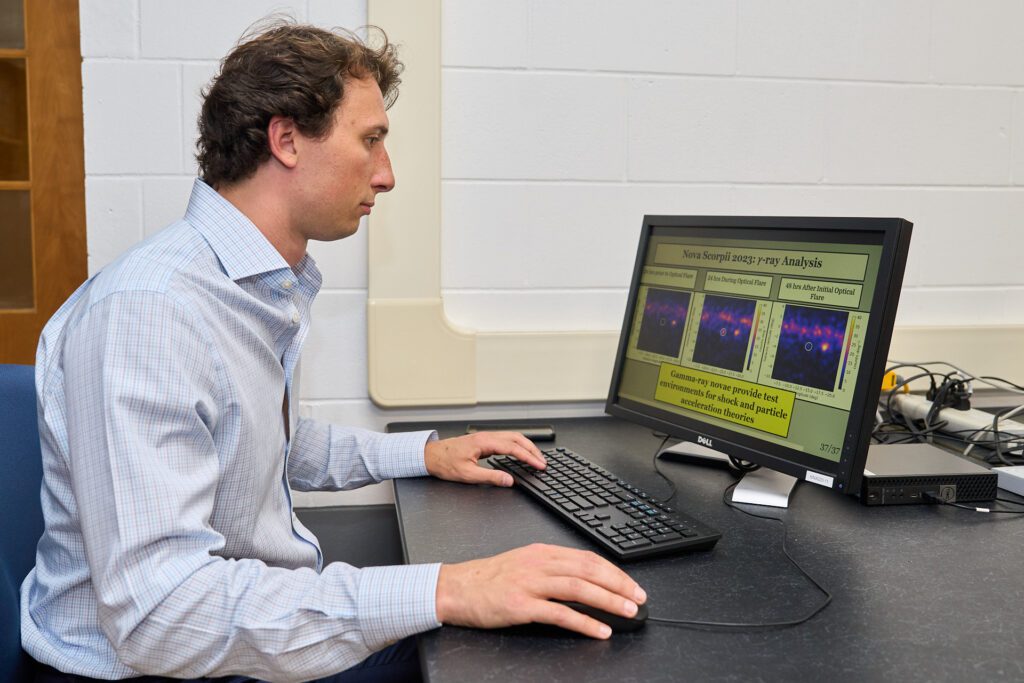Scott Joffre wanted to better understand the nature of existence and appreciate the humility one feels when looking into the cosmos.
“By looking at the extreme environments, you can see how nature behaves in sort of a wild way,” he says.
The extreme is what landed Joffre at Clemson University.

He came to Clemson specifically to work with Professor Marco Ajello and study blazars, a type of galaxy known as active galactic nuclei, which are powered by supermassive black holes and are among the brightest, most energetic objects in the sky.
Light comes in many forms, from frequencies people regularly experience, such as radio, visible light and X-rays, tohigh-energy gamma rays.
Other scientists have mapped out the sky using different frequencies of light. Joffre’s work focuses on mapping space in gamma rays at a specific energy band. This energy band has around a million times more energy than visible light. Research on these gamma rays is essential because of the lack of sensitive observations over the last two decades. Detecting these energetic gamma-rays is difficult because of how light interacts with matter and because of high levels of background noise, making it difficult to isolate signals from astrophysical sources.
Pushing technological capabilities
Currently, one satellite in space detects light at energies specific to Joffre’s research. Scientists have typically used the satellite to collect data on higher energy gamma rays, but Joffre has been able to push its technological capabilities, enabling him to use it for his research.
By collecting this data, scientists can catalog space objects that emit gamma rays to map the gamma-ray sky, identify new galactic and extragalactic objects, and look at known gamma-ray emitting objects from different energies.
Joffre has found objects that previously were undiscovered. “This energy range has not been well studied, and at least not at the sensitivity we’re looking at. Almost any time a new energy range has been studied in astrophysics, a new object has been discovered,” said Joffre, who expects to graduate in May.
While at Clemson, Joffre joined the Science Student Advisory Board, where he and another graduate student started a podcast called “Breaking Silos,” to make the College of Science more interdisciplinary. The podcast was a platform for graduate students to practice speaking about their research while teaching fellow students about different research at Clemson.
Exploring potential path
Last summer, Joffre interned at NASA’s Goddard Space Flight Center in Greenbelt, Maryland, and explored his potential future career path.
“I started using the bathroom in a different building because when you walked into the lobby of that other building, there was a Nobel Prize in a case. And so, I was like, why use the bathroom here when I could walk by a Nobel Prize medal every day? That sort of shows you the impact and the amount of science that is being done at a place like Goddard,” he said.
While he was an undergraduate student at Hope College in Holland, Michigan, Joffre interned for General Atomics, working on laser communication systems. Six years later, Joffre began working on laser communications again at Goddard, where he discovered a potential career path after graduation: satellite communication systems.
“Grad school is a unique opportunity to solve a unique problem. Whatever I want to do next, I’d want to do something like that. I want to pursue a unique problem,” he says.

Historically, satellites have communicated with Earth through radio frequencies. Due to radio’s longer wavelength, information can be transmitted through clouds or around buildings. Still, the amount of information you can communicate is limited due to its lower frequency.
Laser or infrared communication is a potential alternative. Infrared waves have shorter wavelengths but a higher frequency, which allows scientists to encode 10 to 200 times more information into transmissions than with radio frequencies. Laser communication reduces power consumption and spacecraft weight, making space launches more economical. Laser communication also can travel farther distances than radio communication without losing as much power.
Joffre analyzed an experimental satellite called the Laser Communication Relay Demonstration (LCRD), which sends information to a ground station or other satellites with a laser beam. His job was to better understand how the LCRD performs, especially when compared to radio frequencies.
Due to the smaller wavelengths of infrared light, weather can severely impact laser communication. “But there’s a lot of reason to expect that laser communications will be used in the future, especially if we want to go to Mars or anywhere further out,” Joffre says, adding that radio signals weaken with distance more so than collimated laser signals do.
Outside of the lab, Joffre enjoys music. He and a friend started playing in Pickens, South Carolina every Tuesday, where Joffre plays the electric bass and ukulele. In his free time, Joffre takes advantage of the outdoor recreation at Clemson by sailing on Lake Hartwell, scuba diving, running and hiking.
Get in touch and we will connect you with the author or another expert.
Or email us at news@clemson.edu

